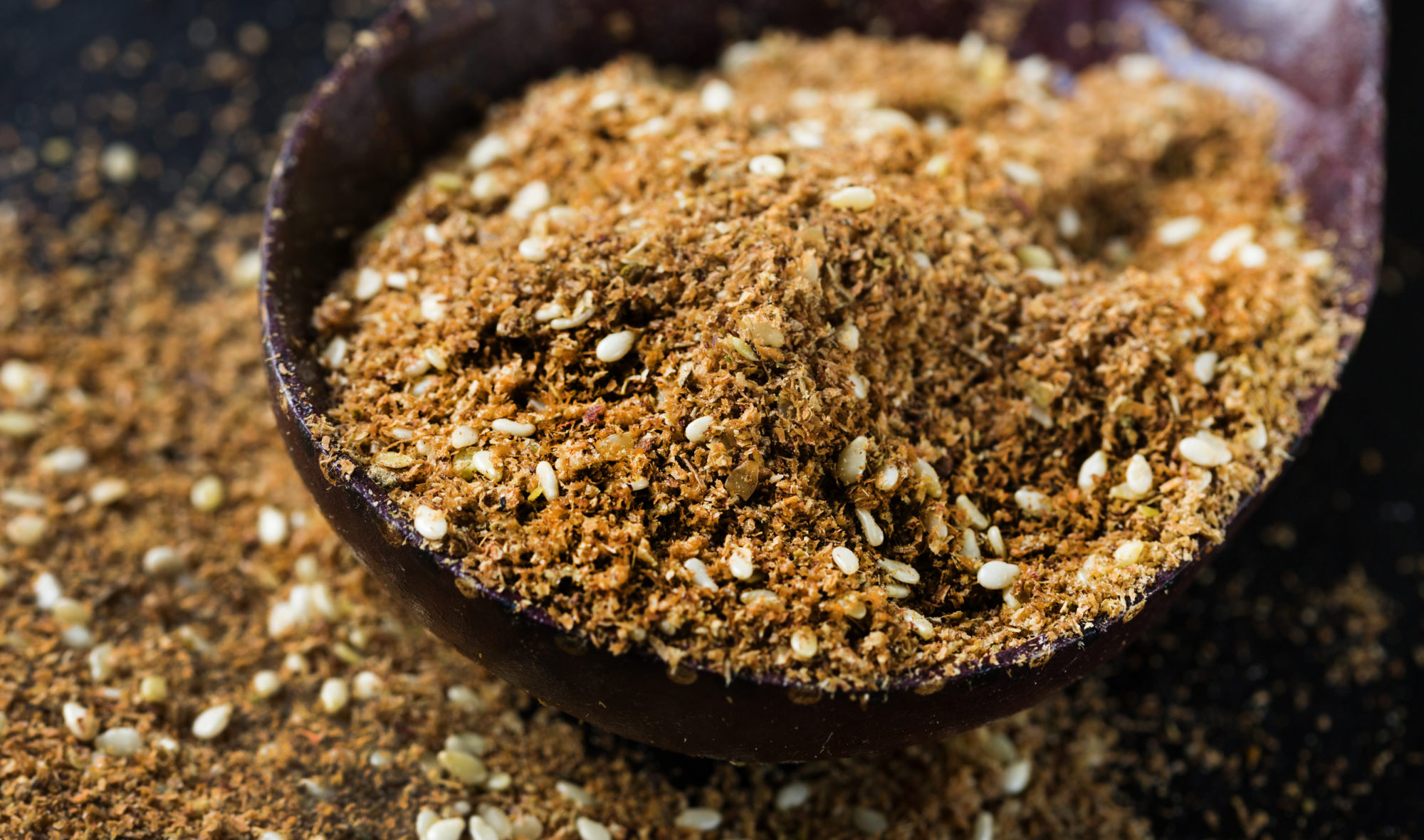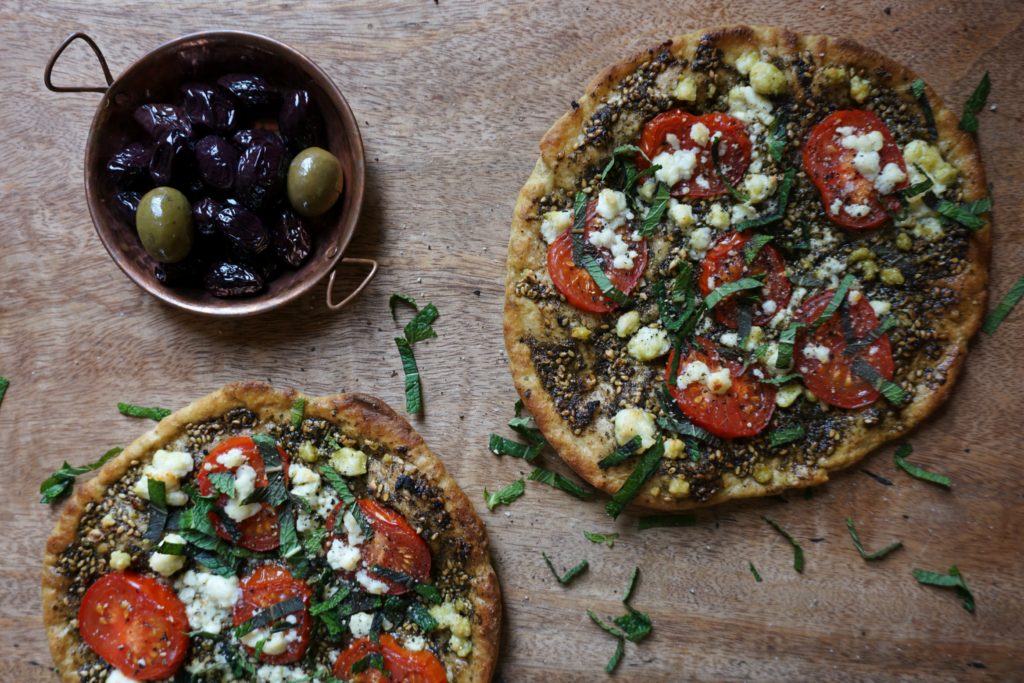
🎁 Holiday Special: SAVE 52% on the Nutrition Coach Starter Package. Limited number remaining.

🎁 Holiday Special: SAVE 52% on the Nutrition Coach Starter Package. Limited # left.

In the Middle East, there is a spice blend known as za’atar (pronounced ZAH-tahr) that is used as commonly as ketchup. Just like ketchup, za’atar contains a mysterious blend of ingredients that varies depending on the kitchen in which it was made. Traditionally, the blend contains varying proportions of oregano, thyme, marjoram, sumac, toasted sesame seeds, and salt, but may also include cumin, turmeric, fennel, hyssop, caraway, or pistachios. Although za’atar is not consumed in amounts great enough to dent macro or micronutrient tallies, the herbs in it contain high amounts of phenolic compounds which have powerful antioxidant activity. Fresh za’atar is a special culinary treat – highly aromatic, nutty, and slightly tangy – so shop at stores with high turnover, or better yet, make it yourself!
Za’atar* (pronounced ZAH-tahr) is a spice blend hailing from the Middle East, where it is used as ordinarily as ketchup. Just like the curry blends of India, za’atar recipes are many and diverse, and in some cases, so secret that the creator of the recipe dies with the formula, without sharing it with a soul.
What’s in your za’atar will depend on which region of the Middle East it was made, and who made it. Generally, za’atar is composed of a blend of oregano, thyme, marjoram, sumac, and toasted sesame seeds. Often, it will also contain salt. However, some recipes may include other ingredients such as cumin, turmeric, fennel, hyssop, caraway, or pistachios.
Za’atar is typically used as a finishing spice, meaning that it is generally used in the final stages of cooking. The herbaceous blend can commonly be found sprinkled over baked pitas; hummus; grilled fish, poultry or meats; or whisked into salad dressings.
*Note that the word za’atar may also refer to a class of herbs which includes some species of oregano and / or marjoram. In this article, the word za’atar refers to the prepared spice blend.
Za’atar usually comes as a partially ground, textured powder. It has a muted, brownish-green color, with flecks of whole sesame seeds visible.
The smell and taste of za’atar is sharp but rich, and deeply aromatic. Although thyme and oregano compose the dominant flavors, there is a prominent nuttiness from the toasted sesame seeds and a slight tang from the dried sumac.
Za’atar, in the amounts typically consumed, is not a significant source of any nutrients.
However, like many herbs and spices, za’atar does add nutrition to foods due to the presence of phenolic compounds found in thyme and oregano, which have powerful antioxidant properties.
As with all dried spices, freshness is key. For this reason, shop at stores or spice markets with high product turnover.
If you can, ask to taste or at least smell the product before buying. Fresh spices will have a strong and bright odor that rises sharply in the nostrils. Spices past their prime will smell like little more than a pile of dust bunnies.
Good quality za’atar will smell sharp and almost spicy, with a rich nuttiness. If you detect a musty or rancid odor, shop elsewhere.
If za’atar is hard to find, a simple solution is to buy the ingredients separately and make the blend yourself.
Here is a basic recipe:
Stir all ingredients in a bowl and then partially crush using a pestle and mortar or a coffee mill. Don’t crush or mill the mixture too much; you want the end result to be slightly textured, with flecks of whole sesame seeds still visible.
Store za’atar in a sealed container at room temperature, ideally away from heat and light, such as a closed cupboard or drawer away from the oven.
Za’atar will lose flavor over time, and the oil from the sesame seeds can turn bitter and rancid, therefore your spice blend should be used within six to eight months after purchasing / preparing.
Za’atar is typically used as a finishing spice, so it should generally only be added to the final stages of cooking.
Sprinkle the spice blend over savory baked breads, over hummus or yogurt-based dips, or over salads. Za’atar, with a little bit of olive oil, can also be rubbed into poultry or meats or dusted over white fish, then baked or grilled.

You can make these pizzas in the time it takes to call and deliver a pizza! An aromatic blend of za’atar, garlic, and olive oil takes the place of tomato sauce in these fun and easy to make personal pizzas. You can choose whichever toppings you like, although tomatoes, feta, and mint are a classic and highly suggested combination.
Prep Time: 10 minutes Cook Time: 15 minutes Yield: 2 servings
Add za’atar, minced garlic, and olive oil to a small bowl and whisk to combine. Spread in a thin layer across two pitas.
Place pitas on a parchment-lined baking tray in a 400 degree Fahrenheit oven and bake for 3 minutes. Remove from the oven, then layer tomatoes slices and crumbled feta over top.
Place back in the oven, and bake for 6 minutes, then turn the oven to broil and broil for 2-3 minutes, or until the edges of the cheese turn golden. Remove from the oven, season with salt and pepper, sprinkle with fresh chopped mint and an extra drizzle of olive oil if desired, then serve.
Precision Nutrition’s Encyclopedia of Food expands every single month as we highlight new foods and showcase beautiful food photography. If you’d like to stay up to date, simply click this link. From there, we’ll send you a FREE copy of our recipe book. We’ll also let you know when new and delicious foods are added to the site.
In the Middle East, there is a spice blend known as za’atar (pronounced ZAH-tahr) that is used as commonly as ketchup. Just like ketchup, za’atar contains a mysterious blend of ingredients that varies depending on the kitchen in which it was made. Traditionally, the blend contains varying proportions of oregano, thyme, marjoram, sumac, toasted sesame seeds, and salt, but may also include cumin, turmeric, fennel, hyssop, caraway, or pistachios. Although za’atar is not consumed in amounts great enough to dent macro or micronutrient tallies, the herbs in it contain high amounts of phenolic compounds which have powerful antioxidant activity. Fresh za’atar is a special culinary treat – highly aromatic, nutty, and slightly tangy – so shop at stores with high turnover, or better yet, make it yourself!